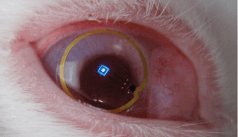That glint in your eye could be a message
on

Researchers at the University of Washington (USA) and Aalto University (Finland) have built a computerised contact lens and demonstrated its safety by testing it on live eyes. The current lens has just one pixel, but the researchers regard it as a proof of concept device for making lenses with multiple pixels which potentially could be used to project short emails and text messages right into the eye.
The contact lens contains an antenna for harvesting energy transmitted by an external source and an IC that stores the energy and powers a transparent sapphire chip with a single blue LED.
In a more elaborate version, it could overlay computer-generated visual information onto real-world imagery and be used in gaming devices and navigation systems. It could also be linked to biosensors in the user's body to provide current information on glucose or lactate levels.
One major problem confronting the researchers is that the human eye has a minimum focal distance of several centimetres and cannot resolve objects on a contact lens, so the image would appear blurry. They solved this problem by integrating Fresnel lenses into the device. These nearly planar lenses focus the projected image onto the retina.
After the contact lens was tested on its own, it was fitted to the eye of a rabbit, in compliance with strict guidelines for using animals as experimental subjects, to evaluate the effect of the contact lens on the cornea and the body in general. In addition to visualisation techniques, the rabbit’s eye was stained with a fluorescent dye to check for abrasion or thermal burning.
According to the head of the research team, the wireless power transmission range needs to be increased by improving the design of the antenna and matching network and optimising the transmission frequency, but their next goal is to incorporate predefined text in the contact lens.
Image: University of Washington



Discussion (0 comments)